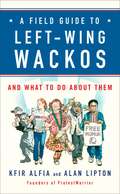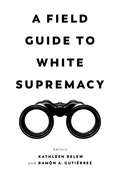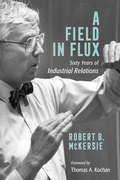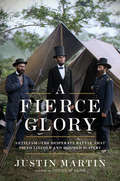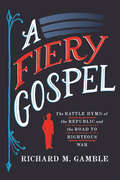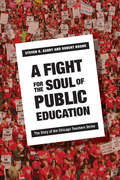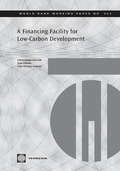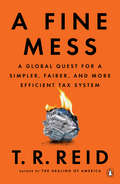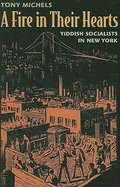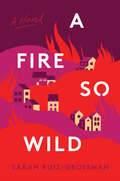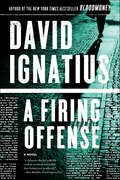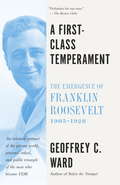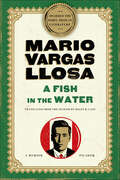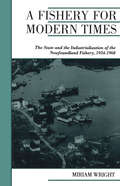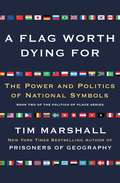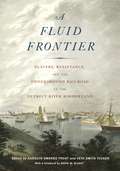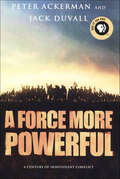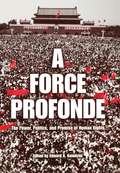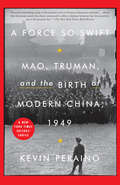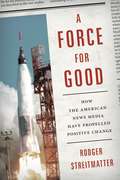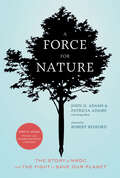- Table View
- List View
A Field Guide to Left-Wing Wackos
by Kfir Alfia Alan LiptonHere's everything you need to know about Anarchists, Peace Moms, Granolas, and many other types of left-wing wackos...so you can annoy them before they annoy you! Dreadlocks. Megaphones. The stench of patchouli oil and bad ideas. Who are these ridiculous characters clogging our streets and college campuses, protesting everything from "American imperialism" to genetically modified food to tax cuts? And how can an articulate, employed, sane person like yourself glean entertainment value from their antics? Kfir Alfia and Alan Lipton, the founders of ProtestWarrior, America's leading antiactivist organization, have spent years studying the eighteen distinct species of leftist protesters in our midst-everyone from Blacktivists to Hacktivists to Islamothugs. And in this hilarious guide, they will teach you: How to easily differentiate among similar species like Communists, Anarchists, and College Students. How to recognize the subtleties of the Performance Artist versus the Dylan Wannabe and the Acid Freak versus the Granola. How to confront, tease and taunt these wackos with witty comebacks, demolishing zingers, and infuriating facts. (Here's one: "War never solved anything ... except for slavery, fascism, Nazism and communism!") A Field Guide to Left Wing Wackos is the manual you want at your fingertips to defend yourself and the American Way-and have some fun while you're at it.
A Field Guide to White Supremacy
by Kathleen Belew and Ramón A. GutiérrezDrawing explicit lines, across time and a broad spectrum of violent acts, to provide the definitive field guide for understanding and opposing white supremacy in America Hate, racial violence, exclusion, and racist laws receive breathless media coverage, but such attention focuses on distinct events that gain our attention for twenty-four hours. The events are presented as episodic one-offs, unfortunate but uncanny exceptions perpetrated by lone wolves, extremists, or individuals suffering from mental illness—and then the news cycle moves on. If we turn to scholars and historians for background and answers, we often find their knowledge siloed in distinct academic subfields, rarely connecting current events with legal histories, nativist insurgencies, or centuries of misogynist, anti-Black, anti-Latino, anti-Asian, and xenophobic violence. But recent hateful actions are deeply connected to the past—joined not only by common perpetrators, but by the vast complex of systems, histories, ideologies, and personal beliefs that comprise white supremacy in the United States. Gathering together a cohort of researchers and writers, A Field Guide to White Supremacy provides much-needed connections between violence present and past. This book illuminates the career of white supremacist and patriarchal violence in the United States, ranging across time and impacted groups in order to provide a working volume for those who wish to recognize, understand, name, and oppose that violence. The Field Guide is meant as an urgent resource for journalists, activists, policymakers, and citizens, illuminating common threads in white supremacist actions at every scale, from hate crimes and mass attacks to policy and law. Covering immigration, antisemitism, gendered violence, lynching, and organized domestic terrorism, the authors reveal white supremacy as a motivating force in manifold parts of American life. The book also offers a sampling of some of the most recent scholarship in this area in order to spark broader conversations between journalists and their readers, teachers and their students, and activists and their communities. A Field Guide to White Supremacy will be an indispensable resource in paving the way for politics of alliance in resistance and renewal.
A Field in Flux: Sixty Years of Industrial Relations
by Robert B. McKersieA Field in Flux chronicles the extraordinary journey of industrial and labor relations expert Robert McKersie. One of the most important industrial relations scholars and leaders of our time, McKersie pioneered the study of labor negotiations, helping to formulate the concepts of distributive and integrative bargaining that have served as analytical tools for understanding the bargaining process more generally.The book provides a window into McKersie's life and work and its impact on the evolution of labor and industrial relations. Spanning six decades, the reader learns about the intersection of labor and the Civil Rights movement, the watershed moment of the Air Traffic Controller's Strike, his relationship with George Schultz, the shift from labor relations to human resource management, and McKersie's role in the seminal cases (Motorola, GM, Toyota) of the labor movement. A Field in Flux serves two important functions: it demonstrates how people have influenced past employment policies and practices when called to action in critical situations, and it seeks to instill confidence in those who will be called on to address the big challenges facing the future of work today and in the years to come. During a time when the basic values of industrial relations are being challenged and violated, McKersie argues that the profession must adapt to the changing world of work and not forget about the value placed on efficiency, equity, and inclusive employment policies and practices.
A Fierce Glory: Antietam--The Desperate Battle That Saved Lincoln and Doomed Slavery
by Justin MartinOn September 17, 1862, the "United States" was on the brink, facing a permanent split into two separate nations. America's very future hung on the outcome of a single battle--and the result reverberates to this day. Given the deep divisions that still rive the nation, given what unites the country, too, Antietam is more relevant now than ever.The epic battle, fought near Sharpsburg, Maryland, was a Civil War turning point. The South had just launched its first invasion of the North; victory for Robert E. Lee would almost certainly have ended the war on Confederate terms. If the Union prevailed, Lincoln stood ready to issue the Emancipation Proclamation. He knew that freeing the slaves would lend renewed energy and lofty purpose to the North's war effort. Lincoln needed a victory to save the divided country, but victory would come at a price. Detailed here is the cannon din and desperation, the horrors and heroes of this monumental battle, one that killed 3,650 soldiers, still the highest single-day toll in American history.Justin Martin, an acclaimed writer of narrative nonfiction, renders this landmark event in a revealing new way. More than in previous accounts, Lincoln is laced deeply into the story. Antietam represents Lincoln at his finest, as the grief-racked president--struggling with the recent death of his son, Willie--summoned the guile necessary to manage his reluctant general, George McClellan. The Emancipation Proclamation would be the greatest gambit of the nation's most inspired leader. And, in fact, the battle's impact extended far beyond the field; brilliant and lasting innovations in medicine, photography, and communications were given crucial real-world tests. No mere gunfight, Antietam rippled through politics and society, transforming history.A Fierce Glory is a fresh and vibrant account of an event that had enduring consequences that still resonate today.
A Fiery Gospel: The Battle Hymn of the Republic and the Road to Righteous War (Religion and American Public Life)
by Richard M. GambleSince its composition in Washington's Willard Hotel in 1861, Julia Ward Howe's "Battle Hymn of the Republic" has been used to make America and its wars sacred. Few Americans reflect on its violent and redemptive imagery, drawn freely from prophetic passages of the Old and New Testaments, and fewer still think about the implications of that apocalyptic language for how Americans interpret who they are and what they owe the world. In A Fiery Gospel, Richard M. Gamble describes how this camp-meeting tune, paired with Howe's evocative lyrics, became one of the most effective instruments of religious nationalism. He takes the reader back to the song's origins during the Civil War, and reveals how those political and military circumstances launched the song's incredible career in American public life. Gamble deftly considers the idea behind the song—humming the tune, reading the music for us—all while reveling in the multiplicity of meanings of and uses to which Howe's lyrics have been put. "The Battle Hymn of the Republic" has been versatile enough to match the needs of Civil Rights activists and conservative nationalists, war hawks and peaceniks, as well as Europeans and Americans. This varied career shows readers much about the shifting shape of American righteousness. Yet it is, argues Gamble, the creator of the song herself—her Abolitionist household, Unitarian theology, and Romantic and nationalist sensibilities—that is the true conductor of this most American of war songs. A Fiery Gospel depicts most vividly the surprising genealogy of "The Battle Hymn of the Republic," and its sure and certain position as a cultural piece in the uncertain amalgam that was and is American civil religion.
A Fight for the Soul of Public Education: The Story of the Chicago Teachers Strike
by Robert Bruno Steven AshbyIn reaction to the changes imposed on public schools across the country in the name of "education reform," the Chicago Teachers Union redefined its traditional role and waged a multidimensional fight that produced a community-wide school strike and transformed the scope of collective bargaining into arenas that few labor relations experts thought possible. Using interviews, first-person accounts, participant observation, union documents, and media reports, Steven K. Ashby and Robert Bruno tell the story of the 2012 strike that shut down the Chicago school system for seven days. A Fight for the Soul of Public Education takes into account two overlapping, parallel, and equally important stories. One is a grassroots story of worker activism told from the perspective of rank-and-file union members and their community supporters. Ashby and Bruno provide a detailed account of how the strike became an international cause when other teachers unions had largely surrendered to corporate-driven education reform. The second story describes the role of state and national politics in imposing educational governance changes on public schools and draconian limitations on union bargaining rights. It includes a detailed account of the actual bargaining process revealing the mundane and the transcendental strategies of both school board and union representatives.
A Fighting Chance
by Elizabeth WarrenAn unlikely political star tells the inspiring story of the two-decade journey that taught her how Washington really works—and really doesn’t As a child in small-town Oklahoma, Elizabeth Warren yearned to go to college and then become an elementary school teacher—an ambitious goal, given her family’s modest means. Early marriage and motherhood seemed to put even that dream out of reach, but fifteen years later she was a distinguished law professor with a deep understanding of why people go bankrupt. Then came the phone call that changed her life: could she come to Washington DC to help advise Congress on rewriting the bankruptcy laws? Thus began an impolite education into the bare-knuckled, often dysfunctional ways of Washington. She fought for better bankruptcy laws for ten years and lost. She tried to hold the federal government accountable during the financial crisis but became a target of the big banks. She came up with the idea for a new agency designed to protect consumers from predatory bankers and was denied the opportunity to run it. Finally, at age 62, she decided to run for elective office and won the most competitive—and watched—Senate race in the country. In this passionate, funny, rabble-rousing book, Warren shows why she has chosen to fight tooth and nail for the middle class—and why she has become a hero to all those who believe that America’s government can and must do better for working families.
A Fighting Chance
by Elizabeth WarrenA NEW YORK TIMES BESTSELLER An unlikely political star tells the inspiring story of the two-decade journey that taught her how Washington really works—and really doesn't—in A Fighting ChanceAs a child in small-town Oklahoma, Elizabeth Warren yearned to go to college and then become an elementary school teacher—an ambitious goal, given her family's modest means. Early marriage and motherhood seemed to put even that dream out of reach, but fifteen years later she was a distinguished law professor with a deep understanding of why people go bankrupt. Then came the phone call that changed her life: could she come to Washington DC to help advise Congress on rewriting the bankruptcy laws?Thus began an impolite education into the bare-knuckled, often dysfunctional ways of Washington. She fought for better bankruptcy laws for ten years and lost. She tried to hold the federal government accountable during the financial crisis but became a target of the big banks. She came up with the idea for a new agency designed to protect consumers from predatory bankers and was denied the opportunity to run it. Finally, at age 62, she decided to run for elective office and won the most competitive—and watched—Senate race in the country. In this passionate, funny, rabble-rousing book, Warren shows why she has chosen to fight tooth and nail for the middle class—and why she has become a hero to all those who believe that America's government can and must do better for working families.
A Financing Facility for Low-Carbon Development in Developing Countries
by Philippe Ambrosi Ivan ZelenkoThis paper proposes an innovative financing mechanism, known as the Low Carbon Development Facility (LCDF) that would bring additional investment financing at concessional rates to unlock low carbon development projects in non-Annex 1 countries, increasing project-based emissions avoidance in these countries. The LCDF could be a modality of the Copenhagen Green Climate Fund to implement the financial pledges made by Annex 1 countries as a result of Copenhagen and post-COP15 negotiations to support projects, programs, policies and/or other activities in developing countries related to NAMAs. LCDF will not substitute the Global Environment Facility (GEF) and the Clean Technology Fund (CTF) and would rather support the innovative projects pioneered by these instruments.
A Fine Mess: A Global Quest for a Simpler, Fairer, and More Efficient Tax System
by T. R. ReidThe U.S. tax code is a total write-off. Crammed with loopholes and special interest provisions, it works for no one except tax lawyers, accountants, and huge corporations. Not for the first time, we have reached a breaking point. That happened in 1922, and again in 1954, and again in 1986. In other words, every thirty-two years. Which means that the next complete overhaul is due in 2018. But what should be in this new tax code? Can we make the U.S. tax system simpler, fairer, and more efficient? Yes, yes, and yes. Can we cut tax rates and still bring in more revenue? Yes. Other rich countries, from Estonia to New Zealand to the UK—advanced, high-tech, free-market democracies—have all devised tax regimes that are equitable, effective, and easy on the taxpayer. But the United States has languished. So byzantine are the current statutes that, by our government’s own estimates, Americans spend six billion hours and $10 billion every year preparing and filing their taxes. In the Netherlands that task takes a mere fifteen minutes! Successful American companies like Apple, Caterpillar, and Google effectively pay no tax at all in some instances because of loopholes that allow them to move profits offshore. Indeed, the dysfunctional tax system has become a major cause of economic inequality. In A Fine Mess, T. R. Reid crisscrosses the globe in search of the exact solutions to these urgent problems. With an uncanny knack for making a complex subject not just accessible but gripping, he investigates what makes good taxation (no, that’s not an oxymoron) and brings that knowledge home where it is needed most. Never talking down or reflexively siding with either wing of politics, T. R. Reid presses the case for sensible root-and-branch reforms with a companionable ebullience. This affects everyone. Doing our taxes will never be America's favorite pastime, but it can and should be so much easier and fairer.
A Fire In Their Hearts: Yiddish Socialists In New York
by Tony MichelsIn a compelling history of the Jewish community in New York during four decades of mass immigration, Tony Michels examines the defining role of the Yiddish socialist movement in the American Jewish experience. <p><p> The movement, founded in the 1880s, was dominated by Russian-speaking intellectuals, including Abraham Cahan, Mikhail Zametkin, and Chaim Zhitlovsky. Socialist leaders quickly found Yiddish essential to convey their message to the Jewish immigrant community, and they developed a remarkable public culture through lectures and social events, workers' education societies, Yiddish schools, and a press that found its strongest voice in the mass-circulation newspaper Forverts. <p> Arguing against the view that socialism and Yiddish culture arrived as Old World holdovers, Michels demonstrates that they arose in New York in response to local conditions and thrived not despite Americanization, but because of it. And the influence of the movement swirled far beyond the Lower East Side, to a transnational culture in which individuals, ideas, and institutions crossed the Atlantic. New York Jews, in the beginning, exported Yiddish socialism to Russia, not the other way around. <p> The Yiddish socialist movement shaped Jewish communities across the United States well into the twentieth century and left an important political legacy that extends to the rise of neoconservatism. A story of hopeful successes and bitter disappointments, A Fire in Their Hearts brings to vivid life this formative period for American Jews and the American left.
A Fire So Wild: A Novel
by Sarah Ruiz-GrossmanZibby Mag, Electric Literature, The Rumpus, and She Reads Most Anticipated Book of the Year"A complex dissection of the impacts of climate change, with an array of characters who feel true and affecting, A Fire So Wild tackles not only a terrifying natural disaster, but the scorching inequality of the aftermath, and demands that we don't look away." -- Charlotte McConaghy, New York Times bestselling author of Once There Were WolvesWith the emotional echoes of Little Fires Everywhere and the lush atmosphere of Disappearing Earth, a riveting debut novel in which a wildfire creeps toward Berkeley, California, igniting tensions as characters from all walks of life confront the injustices lying beneath the city’s surface.As a wildfire threatens Berkeley, the city’s inhabitants are forced to reckon with the cracks in the lives they've built.Abigail, a wealthy homeowner, decides to throw a lavish birthday in a hillside mansion to raise money for the city’s newest affordable housing project—and prove to her family that she’s made something worthwhile of her life. Sunny, a construction worker who sleeps in a van along the bay’s shore, is in the running for an apartment—but only if enough funds are raised at the party.As the heat and smoke from the approaching blaze descend upon the town, tensions rise and residents—young and old, haves and have nots—confront the inequities laid bare, and the fragility of building a life in a world on fire.Alternating among a colorful cast of characters, A Fire So Wild is a timely, tautly paced novel that questions why when everything burns, not everyone is left with scars.
A Fire in Zion: The Israeli-Palestinian Search for Peace
by Mark PerryAttempts to reach peace between Israel and the Palestinians.
A Firing Offense: A Novel
by David Ignatius"A dynamic thriller with the coolest, smartest journalist that fiction ever produced." —Ben Bradlee, Washington PostWhen rising-star reporter Eric Truell accepts information from a maverick CIA agent, he becomes enmeshed in an international trade war in which even his own newspaper may be an unsuspecting participant. When Eric's sources tell him there is a spy inside the newsroom, he is tempted to cross a dangerous professional line and risk his career—possibly even his life—to find the truth.
A First Class Temperament: The Emergence of Franklin Roosevelt, 1905-1928
by Geoffrey C. WardIn this classic of American biography, based upon thousands of original documents, many never previously published, the prize-winning historian Geoffrey C. Ward tells the dramatic story of Franklin Roosevelt's unlikely rise from cloistered youth to the brink of the presidency with a richness of detail and vivid sense of time, place, and personality usually found only in fiction.<P> In these pages, FDR comes alive as a fond but absent father and an often unfeeling husband--the story of Eleanor Roosevelt's struggle to build a life independent of him is chronicled in full-as well as a charming but pampered patrician trying to find his way in the sweaty world of everyday politics and all-too willing willing to abandon allies and jettison principle if he thinks it will help him move up the political ladder. But somehow he also finds within himself the courage and resourcefulness to come back from a paralysis that would have crushed a less resilient man and then go on to meet and master the two gravest crises of his time.<P> This is a sequel to Before the Trumpet: Young Franklin Roosevelt, 1882-1905
A Fish in the Water: A Memoir
by Mario Vargas LlosaIn this literary memoir, the Nobel Prize–winning author and Peruvian politician shares “a convincing self-portrait . . . an often funny and cautionary tale” (Time).In 1990, Mario Vargas Llosa decided to run for the presidency of his native Peru. He campaigned on a platform of economic reform and stringent counterterrorism against the far-left gorilla group, Sendero Luminoso. His failed campaign against Alberto Fujimori generated international headlines, transforming the renowned author into a politician of world stature.A Fish in the Water is Vargas Llosa’s personal account of his life as seen through the lens of his time as a candidate. He evokes the experiences that gave rise to his fiction, while—in parallel—he describes the social, literary, and political influences that led him to enter the political arena as a crusader for democracy and a free-market economy.
A Fishery for Modern Times
by Miriam WrightIn the early 1990s, the northern cod populations off the coast of Newfoundland had become so depleted that the federal government placed a moratorium on commercial fishing. The impact was devastating, both for Newfoundland's economy and for local fishing communities. Today, although this natural resource - exploited commercially for over 500 years - appears to be returning in diminished numbers, many fisheries scientists and fishers question whether the cod will ever return to its former abundance.In A Fishery for Modern Times, Miriam Wright argues that the recent troubles in the fishery can be more fully understood by examining the rise of the industrial fishery in the mid-twentieth century. The introduction of new harvesting technologies and the emergence of 'quick freezing', in the late 1930s, eventually supplanted household production by Newfoundland's fishing families. While the new technologies increased the amount of fish caught in the northwest Atlantic, Wright argues that the state played a critical role in fostering and financing the industrial frozen fish sector. Many bureaucrats and politicians, including Newfoundland's premier, Joseph Smallwood, believed that making the Newfoundland fishery 'modern', with centralization, technology, and expertise, would transform rural society, solving deep-seated economic and social problems.A Fishery for Modern Times examines the ways in which the state, ideologies of development, and political, economic, and social factors, along with political actors and fishing company owners, contributed to the expansion of the industrial fishery from the 1930s through the 1960s. While the promised prosperity never fully materialized, the continuing reliance on approaches favouring high-tech, big capital solutions put increasing pressure on cod populations in the years that followed. As Wright concludes, 'We can no longer afford to view the fisheries resources as "property" of the state and industry, to do with it as they choose. That path had led only to devastation of the resource, economic instability, and great social upheaval.'
A Flag Worth Dying For: The Power and Politics of National Symbols (Politics of Place #2)
by Tim MarshallCombining keen analysis of current events with world history, Tim Marshall, author of the New York Times bestseller Prisoners of Geography, provides &“an entertaining whistle-stop tour of world flags&” (Library Journal)—how their power is used to unite and divide populations and intimidate enemies.For thousands of years flags have represented our hopes and dreams. We wave them. Burn them. March under their colors. And still, in the twenty-first century, we die for them. Flags fly at the UN, on Arab streets, from front porches in Texas. They represent the politics of high power as well as the politics of the mob. From the renewed sense of nationalism in China, to troubled identities in Europe and the USA, to the terrifying rise of Islamic State, the world is a confusing place right now and it&’s important to understand the symbols, old and new, that people are rallying around. In nine chapters (covering the USA, UK, Europe, Middle East, Asia, Africa, Latin America, international flags, and flags of terror), Tim Marshall&’s A Flag Worth Dying For is a &“brisk, entertaining read…that successfully answers a puzzling question: how can a simple piece of cloth come to mean so much? Marshall presents an informative survey of these highly visible symbols of national or international pride&” (Publishers Weekly), representing nation states and non-state actors (including ISIS, Hezbollah, and Hamas), and explains how they figure in diplomatic relations and events today. Drawing on more than twenty-five years of global reporting experience to reveal the true meaning behind the symbols that unite us—and divide us—Marshall &“writes with the cool drollery that characterized the work of Christopher Hitchens or Simon Winchester&” (USA TODAY). The &“illuminating&” (The New York Times) A Flag Worth Dying For is a winning combination of current affairs, politics, and world history and &“a treasure vault for vexillologists, full of meaning beyond the hue and thread of the world&’s banners&” (Kirkus Reviews).
A Fluid Frontier: Slavery, Resistance, and the Underground Railroad in the Detroit River Borderland (Great Lakes Books Series)
by David W. Blight Karolyn Smardz Frost Veta Smith TuckerAs the major gateway into British North America for travelers on the Underground Railroad, the U.S./Canadian border along the Detroit River was a boundary that determined whether thousands of enslaved people of African descent could reach a place of freedom and opportunity. In A Fluid Frontier: Slavery, Resistance, and the Underground Railroad in the Detroit River Borderland, editors Karolyn Smardz Frost and Veta Smith Tucker explore the experiences of the area's freedom-seekers and advocates, both black and white, against the backdrop of the social forces--legal, political, social, religious, and economic--that shaped the meaning of race and management of slavery on both sides of the river. In five parts, contributors trace the beginnings of and necessity for transnational abolitionist activism in this unique borderland, and the legal and political pressures, coupled with African Americans' irrepressible quest for freedom, that led to the growth of the Underground Railroad. A Fluid Frontier details the founding of African Canadian settlements in the Detroit River region in the first decades of the nineteenth century with a focus on the strong and enduring bonds of family, faith, and resistance that formed between communities in Michigan and what is now Ontario. New scholarship offers unique insight into the early history of slavery and resistance in the region and describes individual journeys: the perilous crossing into Canada of sixteen-year-old Caroline Quarlls, who was enslaved by her own aunt and uncle; the escape of the Crosswhite family, who eluded slave catchers in Marshall, Michigan, with the help of others in the town; and the international crisis sparked by the escape of Lucie and Thornton Blackburn and others. With a foreword by David W. Blight, A Fluid Frontier is a truly bi-national collection, with contributors and editors evenly split between specialists in Canadian and American history, representing both community and academic historians. Scholars of the Underground Railroad as well as those in borderland studies will appreciate the interdisciplinary mix and unique contributions of this volume.
A Force More Powerful: A Century of Nonviolent Conflict
by Peter Ackerman Jack DuVallThis nationally-acclaimed book shows how popular movements used nonviolent action to overthrow dictators, obstruct military invaders and secure human rights in country after country, over the past century. Peter Ackerman and Jack DuVall depict how nonviolent sanctions--such as protests, strikes and boycotts--separate brutal regimes from their means of control. They tell inside stories--how Danes outmaneuvered the Nazis, Solidarity defeated Polish communism, and mass action removed a Chilean dictator--and also how nonviolent power is changing the world today, from Burma to Serbia.
A Force Profonde: The Power, Politics, and Promise of Human Rights (Pennsylvania Studies in Human Rights)
by Edward A. KolodziejPresenting detailed portraits by leading authorities of the politics of human rights across the major regions of the globe, A Force Profonde: The Power, Politics, and Promise of Human Rights reveals human rights to be a force as powerful as capitalist markets and technological innovation in shaping global governance. Human rights issues mobilize populations regardless of their national, ethnic, cultural, or religious differences. Yet progress in advancing human rights globally, as Edward A. Kolodziej and the other contributors to the volume contend, depends decisively on the local support and the efforts of the diverse and divided peoples of the world—a prerequisite that remains problematic in many parts of the globe.A Force Profonde explores conceptions of human rights from Western as well as other major world traditions in an attempt to dispel the notion that tyranny, culture, and religion are the only challenges to human rights. Focusing on regional patterns of conflict, the authors point out that violations often have to do with disputes over class, social status, economic privilege, and personal power. In addition, they contend that conflicts over identity are more prevalent in the West than commonly thought. Sharply conflicting views are to be found between the European Union and the United States over issues like the death penalty. Splits within the West between rival Christian sects and between religious adherents and partisans of secularization are no less profound than those in other regions.
A Force So Swift: Mao, Truman, and the Birth of Modern China, 1949
by Kevin PerainoA gripping narrative of the Truman Administration's response to the fall of Nationalist China and the triumph of Mao Zedong's Communist forces in 1949--an extraordinary political revolution that continues to shape East Asian politics to this day. In the opening months of 1949, U.S. President Harry S. Truman found himself faced with a looming diplomatic catastrophe--"perhaps the greatest that this country has ever suffered," as the journalist Walter Lippmann put it. Throughout the spring and summer, Mao Zedong's Communist armies fanned out across mainland China, annihilating the rival troops of America's one-time ally Chiang Kai-shek and taking control of Beijing, Shanghai, and other major cities. As Truman and his aides--including his shrewd, ruthless secretary of state, Dean Acheson--scrambled to formulate a response, they were forced to contend not only with Mao, but also with unrelenting political enemies at home. Over the course of this tumultuous year, Mao would fashion a new revolutionary government in Beijing, laying the foundation for the creation of modern China, while Chiang Kai-shek would flee to the island sanctuary of Taiwan. These events transformed American foreign policy--leading, ultimately, to decades of friction with Communist China, a long-standing U.S. commitment to Taiwan, and the subsequent wars in Korea and Vietnam. Drawing on Chinese and Russian sources, as well as recently declassified CIA documents, Kevin Peraino tells the story of this remarkable year through the eyes of the key players, including Mao Zedong, President Truman, Secretary of State Acheson, Minnesota congressman Walter Judd, and Madame Chiang Kai-shek, the influential first lady of the Republic of China. Today, the legacy of 1949 is more relevant than ever to the relationships between China, the United States, and the rest of the world, as Beijing asserts its claims in the South China Sea and tensions endure between Taiwan and the mainland.
A Force for Good: How the American News Media Have Propelled Positive Change
by Rodger StreitmatterAmerica’s news media are relentlessly criticized as too negative, sensationalistic, profit-oriented, and biased, not to mention unpatriotic and a miserable failure at reflecting the nation’s diversity. The author argues, print and broadcast journalists have propelled significant social topics onto the public agenda and helped build support for change. This text draws on both historical and contemporary examples from a wide range of social contexts; the result is a fascinating tour of American history, social change, and the benefits of a robust media. To simply put, this book is driven by the thesis, that journalism has improved this country in an impressively broad range of areas.
A Force for Nature: The Story of NRDC and the Fight to Save Our Planet
by John H. Adams Patricia Adams Air Vice Marshal George BlackThe pioneering environmental activist recounts his decades-long fight for our planet through the NDRC—with a foreword by Robert Redford.In 1970, John H. Adams was fed up with the levels of pollution in New York City. How could he raise children in a place where layers of soot covered the windows? Working as a lawyer for the U.S. Attorney’s office, he and fellow lawyers teamed up to form Natural Resources Defense Council, a grassroots environmental advocacy group. Over the years, NDRC has grown into an international powerhouse with 1.2 million members and a staff of scientists and lawyers whose mission is to safeguard the planet. This inspiring memoir tells the story of the NRDC and the environmental movement it sparked.
